History
 Storms and high winds are not unusual in the Swiss Alps, and flying over any mountain can find a flight crew in hot water. Over the Swiss Alps, on November 18, 1946, the crew of the C-53 Skytrooper with serial 42-68846 that had taken off from Tulln Air Base near Vienna, Austria, was bound for Pisa in Northern Italy, when they encountered problems. The flight took them over Innsbruck in the Western Austrian Alps. While flying over the Canton of Bern, Switzerland, the weather had unknowingly caused them to lose their bearings. Their actual flight path was taking them deeper South, into the Alps of Central Switzerland.
Storms and high winds are not unusual in the Swiss Alps, and flying over any mountain can find a flight crew in hot water. Over the Swiss Alps, on November 18, 1946, the crew of the C-53 Skytrooper with serial 42-68846 that had taken off from Tulln Air Base near Vienna, Austria, was bound for Pisa in Northern Italy, when they encountered problems. The flight took them over Innsbruck in the Western Austrian Alps. While flying over the Canton of Bern, Switzerland, the weather had unknowingly caused them to lose their bearings. Their actual flight path was taking them deeper South, into the Alps of Central Switzerland.
As often occurs in high mountains, the aircraft encountered a violent downdraft, known as a katabatic wind at a speed of 170 miles per hour. The katabatic wind is comparable to a microburst that basically pushes even big jets into the ground on approach flights. The downdraft caused the aircraft to lose height rapidly in poor visibility conditions. There was no time to recover, and at 2:45pm, the plane hit terrain and crash-landed into the Gauli Glacier at an altitude of 10,990 feet. They had gone down just about 8 miles south of the Swiss Air Force Base Meiringen.
The crash had the potential of being a deadly situation. Crashing a plane into terrain…especially at a high altitude is not usually survivable, but this was a God Gift. The crash occurred on snow-covered near-flat terrain with a slightly sloping hill. For the passengers and crew in the aircraft to step out alive…that was the God Gift. Very few people have crashed into terrain and lived tell the story afterwards! The crew was able to send a distress call from the stricken plane that was picked up in Paris and Lyon, but they erroneously presumed that the crash had occurred in the French Alps. Two days later, an officer based in the control tower of the Meiringen airbase, received a message on his frequency as well and gave the alert of a new radio bearing, narrowing the search area to the Gauli Glacier. That’s two days in freezing November nights at 10,990 feet, with only the fuselage to protect them from the elements. There were two sightings during breaks in the clouds, and finally a rescue team made their way up to bring the crew and passengers down. Twelve people survived the crash and lived to tell about it.
After the rescue, the plane sat there in the glacier until the summer of 1947, when the dismantling of the  aircraft started. The most precious parts like engines, and (cockpit) interior were airlifted from the scene. The bend propellers were left behind and the partially empty but intact airframe was left behind on the Glacier, where the ice would slowly grind it to pieces. In 2012, pieces of the C-53 began to appear as the glacier melted in the sunlight. Amazingly, there were no traces of corrosion. While the ice has made its mark on the plane’s structure, rendering it to a state that only remotely resembles the plane, it is still there. It now looks like the plane was torn apart in the crash. Of course, we know that was not the case at all.
aircraft started. The most precious parts like engines, and (cockpit) interior were airlifted from the scene. The bend propellers were left behind and the partially empty but intact airframe was left behind on the Glacier, where the ice would slowly grind it to pieces. In 2012, pieces of the C-53 began to appear as the glacier melted in the sunlight. Amazingly, there were no traces of corrosion. While the ice has made its mark on the plane’s structure, rendering it to a state that only remotely resembles the plane, it is still there. It now looks like the plane was torn apart in the crash. Of course, we know that was not the case at all.

 If you were to travel to Kazakhstan and Uzbekistan, you would see what was once the fourth largest inland body of water in the world. The Aral Sea once had a water surface of 26,254 square miles. The salinity measured at 10g/L (grams of salt per liter of water). In comparison, the oceans are about 35 g/L, and the Dead Sea about 300 g/L. The Aral Sea has no outflow, and is fed by the Amu Darya and Syr Darya (Darya means river). It’s this lack of outflow that explains the high salinity. Still, it is much lass salty than the ocean, and especially much less than the Dead Sea.
If you were to travel to Kazakhstan and Uzbekistan, you would see what was once the fourth largest inland body of water in the world. The Aral Sea once had a water surface of 26,254 square miles. The salinity measured at 10g/L (grams of salt per liter of water). In comparison, the oceans are about 35 g/L, and the Dead Sea about 300 g/L. The Aral Sea has no outflow, and is fed by the Amu Darya and Syr Darya (Darya means river). It’s this lack of outflow that explains the high salinity. Still, it is much lass salty than the ocean, and especially much less than the Dead Sea.
The thing is…the Aral Sea was shrinking. By 1998, it had shrunk to just over 10,810 square miles. At that point, it became only the eighth largest lake in the world, and the salinity had increased to 45 g/L. By 2007, the lake had diminished to only 6,625 square miles, and became two separate basins…The North Aral Sea and the South Aral Sea. Now it is not even in the top ten list of the world’s largest lakes. The South Aral Sea is now further divided into two separate basins, east and west. Salinity in the southern basins is up to over 100 g/L, and has resulted in the death of most of the native flora and fauna of the lake. The lake used to have a fishing industry that supplied Russian markets with almost a quarter of their fish, while employing 40,000 people…but no more. Even the climate in the region has changed, with the loss of so much water, becoming more arid, with significantly decreased precipitation further adding to the decline of the Aral Sea. In total, the surface area has declined 90%, and the volume has decreased by 85%…basically like removing lakes the size of Lake Erie and Lake Ontario combined.
While these facts are strange in and of themselves, I wonder exactly how fast this transformation actually occurred. It is said that the sea level has dropped by over 98 feet in many places, leaving fishing boats stranded more than 60 miles from any shore. The ships were simply high and dry in the middle of the sea that had once been the source of income for their crews. The bottom of the lake became a new desert. The towns that had once been thriving were perched on vanished shorelines with toxic dust storms swirling around in the 
 wind. The people struggle in poverty and high rates of cancer, tuberculosis, digestive disorders, and anemia. The area today seems relatively safe to visit today, at least in the short term. What is interesting about the Aral Sea today is the it is still full of scores of ships…all high and dry on the sand. Why didn’t the owners take their ships away before the sea went dry? I guess maybe they believed the rains would come, and maybe they will, eventually. Unfortunately, it will simply be too late.
wind. The people struggle in poverty and high rates of cancer, tuberculosis, digestive disorders, and anemia. The area today seems relatively safe to visit today, at least in the short term. What is interesting about the Aral Sea today is the it is still full of scores of ships…all high and dry on the sand. Why didn’t the owners take their ships away before the sea went dry? I guess maybe they believed the rains would come, and maybe they will, eventually. Unfortunately, it will simply be too late.
 I don’t know about you, but when I go looking for something I’ve lost, usually because I put it in a place that I would know where to find it, I always seem to find several other “treasures” I had forgotten I had. I can’t tell you how many times that has happened to me, even if I had been intently looking for the “treasure” that I finally find when I’m no longer looking for it. That happens to a lot of people, but it’s not likely that the “treasures” we find, are worth anywhere near the value of the treasure that was found by Eric Lawes, when on November 16, 1992, he set off for a field in Hoxne village, Suffolk. He wasn’t even heading out on a treasure hunt. He was searching for his lost hammer!!
I don’t know about you, but when I go looking for something I’ve lost, usually because I put it in a place that I would know where to find it, I always seem to find several other “treasures” I had forgotten I had. I can’t tell you how many times that has happened to me, even if I had been intently looking for the “treasure” that I finally find when I’m no longer looking for it. That happens to a lot of people, but it’s not likely that the “treasures” we find, are worth anywhere near the value of the treasure that was found by Eric Lawes, when on November 16, 1992, he set off for a field in Hoxne village, Suffolk. He wasn’t even heading out on a treasure hunt. He was searching for his lost hammer!!
At his recent retirement, Lawes had received a metal detector as a gift. So Lawes set off to find a hammer he had lost on the farmland. The detector picked up a strong signal in the earth, leading Lawes to start digging. Well…this was not his hammer. After bringing up only a few shovelfuls of silver spoons and gold coins, Lawes quickly retreated and called the police and the local archaeological society. The very next day, as quietly as possible, so as not to create a stir, the archaeologists excavated a chunk of earth with the treasure still contained within. They wanted to remove the objects under strict laboratory conditions, which would help determine the age and storage method of the cache. By the time everything had been removed from the dirt, the archaeologists had nearly 60 pounds of gold and silver objects, including 15,234 Roman coins, dozens of silver spoons, and 200 gold objects. The treasure, which later became labeled as the Hoxne Hoard, was an amazing discovery. Archaeologist Judith Plouviez was extremely excited about the discovery, saying that it was “an incredibly exciting and amazing find.” What’s more, another archaeologist, Rachel Wilkinson, told Smithsonian Magazine that this discovery was “the largest and latest ever found in Britain.”
Normal radiocarbon dating as a means of identifying the age of ancient relics didn’t work in this case. They just couldn’t locate any suitable material for radiocarbon dating from the haul. In the end, they determined the age 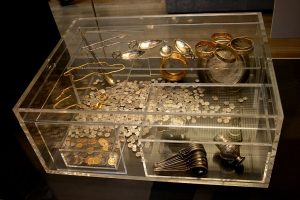 by examining writing on the coins, as well as the ruler carved into them. It was estimated that the treasure was probably buried in either 408 or 409 AD. How it had remained hidden all those years is beyond me…especially on a farm, where the field might have been plowed at any time. All in all, the discovery was a real treasure for archaeologists. Lawes didn’t lose out on the deal either. According to Smithsonian Magazine, in recognition of his discovery and willingness to contact authorities, the British government rewarded him with over £1.7 million (2,249,100 in US Dollars), an amount which he shared with the farmer whose land was dug out in order to get the treasure. Oh, and by the way, Lawes also found his lost hammer…which now also resides in the British Museum too.
by examining writing on the coins, as well as the ruler carved into them. It was estimated that the treasure was probably buried in either 408 or 409 AD. How it had remained hidden all those years is beyond me…especially on a farm, where the field might have been plowed at any time. All in all, the discovery was a real treasure for archaeologists. Lawes didn’t lose out on the deal either. According to Smithsonian Magazine, in recognition of his discovery and willingness to contact authorities, the British government rewarded him with over £1.7 million (2,249,100 in US Dollars), an amount which he shared with the farmer whose land was dug out in order to get the treasure. Oh, and by the way, Lawes also found his lost hammer…which now also resides in the British Museum too.
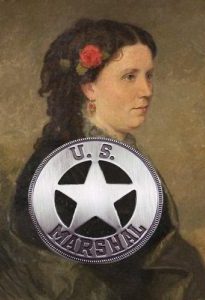 In the days of the Old West, women were considered the “weaker sex” and they were supposed to be cared for and protected by their male counterparts. Most women were fine with that idea, but there were a few, like Annie Oakley and Susan Anderson, who broke the mold. Annie Oakley was an amazing markswoman and Susan Anderson was a doctor. These women weren’t alone in their desire to leave their mark on the world.
In the days of the Old West, women were considered the “weaker sex” and they were supposed to be cared for and protected by their male counterparts. Most women were fine with that idea, but there were a few, like Annie Oakley and Susan Anderson, who broke the mold. Annie Oakley was an amazing markswoman and Susan Anderson was a doctor. These women weren’t alone in their desire to leave their mark on the world.
The world of law enforcement, especially in those days was clearly a man’s world, but in 1891, a woman named F M Miller was commissioned out of the federal court at Paris, Texas as the only female deputy that worked the Indian Territory. Miller was known as a fearless and efficient officer, who had locked up more than a few offenders. She was a “young woman of prepossessing appearance, wears a cowboy hat and is always adorned with a pistol belt full of cartridges and a dangerous looking Colt pistol which she knows how to use.” Apparently, hiring a female deputy wasn’t all that unusual, but the women deputies were known as office deputies, basically a secretary.
Oklahoma has set the pace for something more. United States Marshal C H Thompson, of Guthrie appointed two women as deputies for field work. It was almost unheard of. If a woman choose the vocation of professional thief taker in the most civilized portion of the land would be strange enough, but how strange is it when she chooses field duty on the worst territory in the Union. Criminals in Oklahoma and in Indian Territory, the district where these two girls, S M Burche and Mamie Fossett spent their days, were among the most dangerous anywhere. They were accused of murder, rape, robbery, arson, adultery, bribery, and numerous other crimes. These outlaws initially hid out in Indian Territory, because it was without law enforcement, with the exception of the Indian Nations’ police forces, who had no jurisdiction over the many criminals who had taken flight from other states. The outlaws were ruthless and willing to kill to avoid jailtime. More lives were lost among Federal officers in a year than in all the rest of the nation together. So it would seem that these girls possessed exceptional guts and spunk to willingly undertake such duties.
Burche and Fossett were truly spunky and adventurous women. They had no qualms about invading the newly opened Oklahoma territory. They were young, fairly good-looking, well-educated, fearless, and independent…and they were definitely not Marshal Thompson’s secretaries. When they took the oath of office and assumed their duties it was with distinct understanding that they would serve the Government just as would any other deputy marshal. They were to take the field, serve writs and warrants, and make arrests just as any male deputy might be called on to do. And they did it with great success.

The wildness of the Oklahoma and Indian Territory would soon come to an end when Judge Isaac Parker was appointed to the Western Judicial District of Arkansas, which included Indian Territory. Parker would go on to command about 200 deputy marshals to “clean up” the lawless territory, but that would take years as the deputies struggled to cover the more than 74,000 square miles in their search for hundreds of wanted fugitives. It was not going to be a speedy process. Into this dangerous midst, a number of men made names for themselves. Men such as Heck Thomas, Bass Reeves, Bill Tilghman, Chris Madsen, and dozens of others. More quietly, a few other deputies also made names for themselves. Quietly, because they were women.

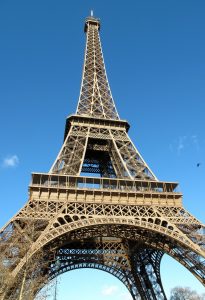 When we think of Paris, the first thing that comes to mind is the Eiffel Tower. If history had been different, those of us alive today would most likely be completely unaware of the historical icon. The Eiffel Tower was built in 1889, and since that time, over 200,000,000 people have visited it, which makes the Eiffel Tower the most visited monument in the world. The Eiffel Tower was erected for the Paris Exposition, and was inaugurated by the Prince of Wales, who went on to become King Edward VII. The tower was the entrance arch to exposition, and was the most visited site during the Exposition. As they were preparing for the Exposition, seven hundred proposals were submitted in a design competition. In the end, it was the radical design of French engineer Alexandre Gustave Eiffel that was unanimously chosen. Eiffel was assisted in the design by two engineers, Maurice Koechlin and Emile Nougier, and architect Stephen Sauvestre.
When we think of Paris, the first thing that comes to mind is the Eiffel Tower. If history had been different, those of us alive today would most likely be completely unaware of the historical icon. The Eiffel Tower was built in 1889, and since that time, over 200,000,000 people have visited it, which makes the Eiffel Tower the most visited monument in the world. The Eiffel Tower was erected for the Paris Exposition, and was inaugurated by the Prince of Wales, who went on to become King Edward VII. The tower was the entrance arch to exposition, and was the most visited site during the Exposition. As they were preparing for the Exposition, seven hundred proposals were submitted in a design competition. In the end, it was the radical design of French engineer Alexandre Gustave Eiffel that was unanimously chosen. Eiffel was assisted in the design by two engineers, Maurice Koechlin and Emile Nougier, and architect Stephen Sauvestre.
Believe it or not, there was some controversy over the winning design. The Paris city government actually received a petition, signed by about 300 people in a effort to prevent the city government from constructing the tower. Some famous personalities like Guy de Maupassant, Emile Zola, and Charles Garnier also signed the petition. They felt that the Eiffel Tower would be useless and monstrous, and it endangered French art and history. Wow!! Today, they would be stunned at the beauty it posses, especially when it is lit up at night.
Of course, the tower was ultimately built and it was given out for a 20-year lease. When the lease expired in 1909, it was planned to tear down the iconic tower. In the end, it was its antenna that saved the tower, as it was used for telegraphy. The tower also played an important role in capturing the infamous spy Mata Hari 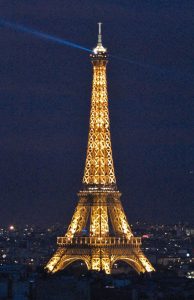
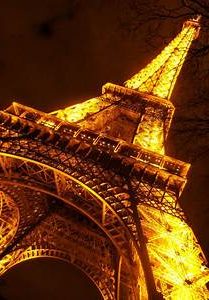 during World War I. Following these events, the tower gained acceptance among the French. As 1910 arrived, the Eiffel Tower became a part of the International Time Service and the French Radio has been using the tower since 1918. The French Television started using the height of the tower from 1957. I don’t really know if most of us knew about all the other uses for the Eiffel Tower, other than the tourist attraction most of us connect with it.
during World War I. Following these events, the tower gained acceptance among the French. As 1910 arrived, the Eiffel Tower became a part of the International Time Service and the French Radio has been using the tower since 1918. The French Television started using the height of the tower from 1957. I don’t really know if most of us knew about all the other uses for the Eiffel Tower, other than the tourist attraction most of us connect with it.
Today this fantastic structure of iron and rivets is iconic symbol of Paris and people from all over the world come to Paris just to marvel at this man-made wonder. The stunning photographs that have been taken from all angles, and the romantic appeal for so many couples of all ages and nationalities have worked together to make the Eiffel Tower famous.
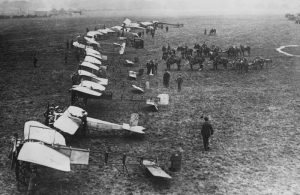 Weapons of warfare have changed over the years, but one of the strangest fighting systems was during World War I, when the planes were not as sophisticated as planes are today. They were slow and at that time, they did not have the guns attached to the planes. Of course they were usually two-seaters, so unlike the World War II planes that had a pilot exclusively assigned to fly the plane, both occupants of the plane had to shoot, or they would be shot down. That was how war was. Kill or be killed.
Weapons of warfare have changed over the years, but one of the strangest fighting systems was during World War I, when the planes were not as sophisticated as planes are today. They were slow and at that time, they did not have the guns attached to the planes. Of course they were usually two-seaters, so unlike the World War II planes that had a pilot exclusively assigned to fly the plane, both occupants of the plane had to shoot, or they would be shot down. That was how war was. Kill or be killed.
The problem of not having guns attached to the plane was really one of control. There was the problem of controlling the plane with shots being fired all around you and no protection in the open cockpit. Then there was controlling the guns in the wind of flight. Not to mention the shots being fired at the open cockpit. The guns the soldiers had on these early planes were carbines and pistols…to take down a war plane…yikes. Of course, there 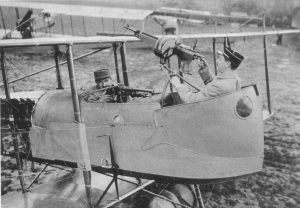 were other problems too. Trying to shoot at the enemy from the cockpit of the plane, the soldier had to be careful not to shoot off the propeller. That would definitely be problematic.
were other problems too. Trying to shoot at the enemy from the cockpit of the plane, the soldier had to be careful not to shoot off the propeller. That would definitely be problematic.
Really, I can’t imagine being a pilot in that war era. You would really be taking your life in your own hands…even more so than the men who flew in later eras, who were also in grave danger, but maybe a little less so. Imagine being the co-pilot in the plane when your pilot is waving his gun around trying to hit the planes flying around you. If the soldier shooting could shoot off the propeller, they could just as easily shoot the other occupant of the plane. I suppose that the pilots fighting in World War I would say that they were just doing their duty, but it seems to me that their “duty” took great courage. Of course, any soldier, no matter what their duty, does their duty, and it always takes great courage. Any soldier 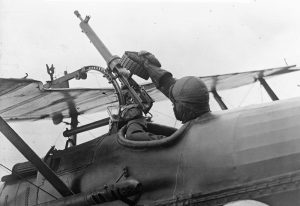 must exhibit great courage in battle. There is no way to go into battle and not be concerned for your safety. And thankfully, as time goes on, weapons of warfare are getting more advanced at being effective, while protecting the soldier in the fight.
must exhibit great courage in battle. There is no way to go into battle and not be concerned for your safety. And thankfully, as time goes on, weapons of warfare are getting more advanced at being effective, while protecting the soldier in the fight.
Of course, those old biplanes had some advantages too. The open cockpit design allowed for easy spying. They could also see the enemy better, and it was easier to drop bombs in those planes, but the later planes made for easier shooting with the attached gun, multiple guns, and the nose guns of the men below the pilots. I’m thankful for the many improvements that have made it easier for our soldiers to come home alive.
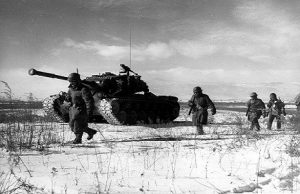 It happened during the Korean War. The First Marine Division was in the middle of heavy fighting in the area of Chosin Mountain Reservoir, and the temperatures were subfreezing. The marines had been fighting long enough to have run out of 60mm mortar ammo. That was not going to make for a successful battle, so the marines called for the 60mm mortar ammo, which had the code name “Tootsie Rolls.” The unfortunate mistake was that the radio operator, didn’t have the code sheets. The radio operator didn’t know what to do, since the request sounded so urgent, so he called in the order.
It happened during the Korean War. The First Marine Division was in the middle of heavy fighting in the area of Chosin Mountain Reservoir, and the temperatures were subfreezing. The marines had been fighting long enough to have run out of 60mm mortar ammo. That was not going to make for a successful battle, so the marines called for the 60mm mortar ammo, which had the code name “Tootsie Rolls.” The unfortunate mistake was that the radio operator, didn’t have the code sheets. The radio operator didn’t know what to do, since the request sounded so urgent, so he called in the order.
Now, just imagine…you are a marine in the middle of a battle, in freezing weather, our of ammo, and headquarters drops in pallet after pallet of Tootsie Rolls!! Well, who can resist Tootsie Rolls…right. So while it wasn’t ammunition, the pallets weren’t the ammunition he really needed, Tootsie Rolls did supply the calories the men needed. They weren’t exactly nutritious, they did give the men energy, which was needed at the time. It is also possible that the Tootsie Rolls helped to keep them warm in the freezing temperatures. They also learned they could use warmed Tootsie Rolls to plug bullet holes, sealing them as they refroze. Interesting idea.
The fighting had been going on for over two weeks. The 15,000 man division suffered 3,000 killed in action, 6,000 wounded and thousands of severe frostbite cases. The battle was a serious matter, but they accomplished their goal and destroyed several Chinese divisions in the process. Many credited their very survival to Tootsie Rolls. Surviving Marines called themselves “The Chosin Few.”
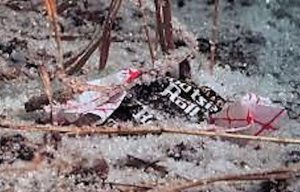
Still, the radio operator had made a serious error, and they couldn’t just let that big an error slide. I can picture it now. The jokes that the poor operator had to face. In fact they probably came up with a Tootsie Roll nickname for him, or maybe they went a different route. He might have been designated a hero for saving them with all those Tootsie Rolls…especially if they sent ammo when the error was brought to light. So, while you might not have known it, Tootsie Rolls hold significance with the Marine Corps. I guess now you know what. Some have even called them the “Tootsie Roll Marines.”
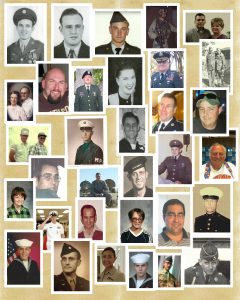 The United States is a great nation, but it would be very hard for a nation to remain great, if that nation did not have a strong military. These days, national security is not guaranteed. That makes our military men and women absolutely essential. All too often, I don’t think we give our veterans the respect and recognition they deserve.
The United States is a great nation, but it would be very hard for a nation to remain great, if that nation did not have a strong military. These days, national security is not guaranteed. That makes our military men and women absolutely essential. All too often, I don’t think we give our veterans the respect and recognition they deserve.
Veterans and soldiers are unique characters. Most of us are not interested in running off to some other country at the drop of a hat to defend people we don’t even know. Nevertheless, when a people are being oppressed, it is a soldier who is called to defend them. These soldiers leave their homes and families, often for months at a time, and go off to another country to defend strangers. They miss births, first steps, school plays, graduations, and so much more. They miss tucking their children in at night,  dropping them off at school in the morning, watching their sporting events, and having weekend barbecues, just to name a few. By the time they have left the military, their children are often mostly grown up. It is time they can never get back, and yet they consider it time well spent, because they did their duty and they saved lives. What more could we ask of them?
dropping them off at school in the morning, watching their sporting events, and having weekend barbecues, just to name a few. By the time they have left the military, their children are often mostly grown up. It is time they can never get back, and yet they consider it time well spent, because they did their duty and they saved lives. What more could we ask of them?
 Veterans Day is a day when we honor those who served and upon their discharge, came back home. In this case, while it does honor veterans who have gone to their Heavenly home, it is not about those killed in action. Theirs is a different day…Memorial Day, the day we remember those lost in battle. All of these men and women served their country and the world, but a veteran came home and lived out their life…hopefully with all their limbs attached, but many times that was not to be either. Those veterans, and those with PTSD need our help badly, but all veterans, no matter what the outcome of their service was, deserve our complete and total respect. Veterans Day began on November 11, 1919, making this year the 101st anniversary of that date. To all those among us who served, thank you for your service, and to those veterans who have gone home, including my dad, Allen Spencer and many family members, I thank you!! Happy Veterans Day.
Veterans Day is a day when we honor those who served and upon their discharge, came back home. In this case, while it does honor veterans who have gone to their Heavenly home, it is not about those killed in action. Theirs is a different day…Memorial Day, the day we remember those lost in battle. All of these men and women served their country and the world, but a veteran came home and lived out their life…hopefully with all their limbs attached, but many times that was not to be either. Those veterans, and those with PTSD need our help badly, but all veterans, no matter what the outcome of their service was, deserve our complete and total respect. Veterans Day began on November 11, 1919, making this year the 101st anniversary of that date. To all those among us who served, thank you for your service, and to those veterans who have gone home, including my dad, Allen Spencer and many family members, I thank you!! Happy Veterans Day.

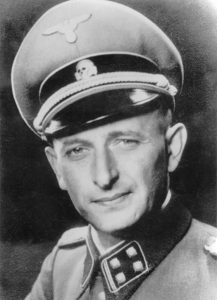 When Hitler decided that the time in his “final solution” had come to transport the Jews, Gypsies, and other “undesirables” to the death camps, he chose to transport them in cattle cars on a train. Hitler had so little compassion for human life, that when the people were loaded into the cattle cars, they were packed in tightly with as many 80 people to a car. They couldn’t sit down. The air was stifling. The trains didn’t stop for bathroom breaks or food. The people had to stand there hour after hour, for up to four very long days. Hitler and his men didn’t care, they didn’t even consider the people to be human, and to make matters worse, they thought it a good thing if the people just died en route, because it would save them the hassle, ammunition, and poison needed to kill them later.
When Hitler decided that the time in his “final solution” had come to transport the Jews, Gypsies, and other “undesirables” to the death camps, he chose to transport them in cattle cars on a train. Hitler had so little compassion for human life, that when the people were loaded into the cattle cars, they were packed in tightly with as many 80 people to a car. They couldn’t sit down. The air was stifling. The trains didn’t stop for bathroom breaks or food. The people had to stand there hour after hour, for up to four very long days. Hitler and his men didn’t care, they didn’t even consider the people to be human, and to make matters worse, they thought it a good thing if the people just died en route, because it would save them the hassle, ammunition, and poison needed to kill them later.
I suppose that for Hitler and the Nazis, the plan was one of simple logistics of transporting millions of people to southern Poland. Some of the people came from as far away as the Netherlands, France, Italy, and Greece. Transportation was done occasionally in passenger trains, in which wealthy Jews were encouraged to bring as much of their wealth with them as possible. Oh course, the Jews thought they would be able to keep their belongings, but in reality, this was railway robbery, because their wealth was soon to be transferred to the Nazis. Where they were going, they would not need their property.
The transports of the Jews to Auschwitz went of daily, on schedule. They leave from the ghetto embarkation depots, on schedule. The process was very methodical…almost mechanical, or robotic. Those in charge had no compassion for the people being herded into the cattle cars. The conductors signaled, “All aboard.” The brakemen waved lanterns. Anyone who resisted was shot by German and Hungarian guards. Guards used clubs and bayonets to herd a last group of mothers into the compartments. Finally, the engineer opens the throttle, and right on schedule, the train is off for Auschwitz.
Eighty Jews in every compartment was the average, but Eichmann boasted that the Germans could do better where there were more children. With the children in the groups, they could jam 120 into each train room. The Jews had to stand all the way to Auschwitz…with their hands raised in the air…because that made room for the maximum number of passengers. Each compartment had two buckets…one containing water, and the other to use as a toilet, to be shoved by foot, if possible, from user to user, not that anyone could use their hands to facilitate waste elimination. Many just had to relieve themselves where they stood, through their clothing. The water buckets made no sense either, because one water bucket for over eighty people for four days, would never be enough, if they could figure out a way to get the water from the bucket to their mouths. Still, no one could say the Nazis were cruel…after all, the buckets were there, right? In the four days that it took to get to Auschwitz, many, if not all of the prisoners were dead, standing up, because in the tight quarters, the dead 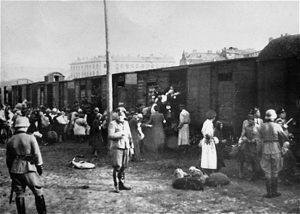
 could not even fall. Those who survived were to face an worse fate than dying on the train. They faced slavery, forced experimentation, and finally the gas chambers. Children were separated from parents, men from women, and the elderly simply sent straight to the gas chambers. People were mutilated, poisoned, beaten, forced to stand outside naked in the bitter cold of winter or in the heat of summer, crammed into quarters with no heat or blankets, and starved to death on a mere 700 calories or less a day. Death was the best option.
could not even fall. Those who survived were to face an worse fate than dying on the train. They faced slavery, forced experimentation, and finally the gas chambers. Children were separated from parents, men from women, and the elderly simply sent straight to the gas chambers. People were mutilated, poisoned, beaten, forced to stand outside naked in the bitter cold of winter or in the heat of summer, crammed into quarters with no heat or blankets, and starved to death on a mere 700 calories or less a day. Death was the best option.
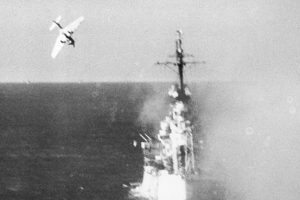 World War II brought with it, something of an anomaly when it came to Japanese pilots…the Kamikaze pilot. It is said that these men “volunteered” for these mission. In an act that can only be described as insane, they flew their fighter planes straight into the ships of the enemy. Most people can’t imagine doing such a thing, and we might even assume that these pilots were really wanting to commit suicide. Most often that was not the case, although I suppose there may have been some who wanted to go down in “a blaze of glory” for their country.
World War II brought with it, something of an anomaly when it came to Japanese pilots…the Kamikaze pilot. It is said that these men “volunteered” for these mission. In an act that can only be described as insane, they flew their fighter planes straight into the ships of the enemy. Most people can’t imagine doing such a thing, and we might even assume that these pilots were really wanting to commit suicide. Most often that was not the case, although I suppose there may have been some who wanted to go down in “a blaze of glory” for their country.
The Japanese government had a unique way of accomplishing what they wanted done. When the new soldiers came into the camps, they were given a piece of paper with three options listed on it. They could volunteer willingly, simply volunteer, or not volunteer. Because the pilots names were on the papers, they felt intimidated. The pressure was intense, and 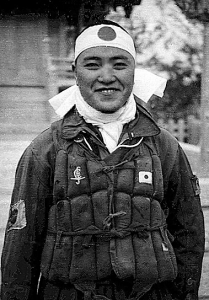 not only to volunteer as kamikaze pilots, but they would jump off a cliff so that they would not be captured. I guess I can understand the fear of capture, but I don’t know that I could take my own life as a means of escaping capture. Most people have such a strong survival instinct that in situations that seem hopeless, they would rather sacrifice a limb than their lives. In fact one such case, a man had been fishing when a boulder rolled down a hill and pinned his hand. He tried everything he could think of to free his hand, and then when there was no other option, he actually chewed his hand off, and got himself to the hospital for treatment. You might say, “well, his hand was probably dead anyway,” and you might be right, but would that inspire you to chew your hand off? I don’t think so, nevertheless, he did it, in order to live. And yet, these Kamikaze pilots flew into planes, ships, or buildings to take out as many people as they could, and in the event of being overtaken by the enemy, they chose suicide.
not only to volunteer as kamikaze pilots, but they would jump off a cliff so that they would not be captured. I guess I can understand the fear of capture, but I don’t know that I could take my own life as a means of escaping capture. Most people have such a strong survival instinct that in situations that seem hopeless, they would rather sacrifice a limb than their lives. In fact one such case, a man had been fishing when a boulder rolled down a hill and pinned his hand. He tried everything he could think of to free his hand, and then when there was no other option, he actually chewed his hand off, and got himself to the hospital for treatment. You might say, “well, his hand was probably dead anyway,” and you might be right, but would that inspire you to chew your hand off? I don’t think so, nevertheless, he did it, in order to live. And yet, these Kamikaze pilots flew into planes, ships, or buildings to take out as many people as they could, and in the event of being overtaken by the enemy, they chose suicide.
Of course, their beliefs were similar to those of the Muslim suicide bombers. They somehow think that there is honor in these acts. In reality, the Kamikaze pilot doesn’t even think about the enemy. It’s really not about the enemy. They think about the “honor” they have been given to give up their life for the emperor. Well, I would give up my life rather than turn my back on God, and I suppose that is sort of what they are doing, but when 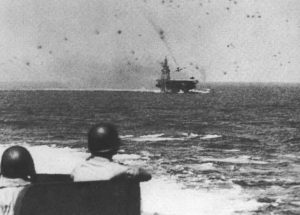 the country’s leader becomes your “god,” you are already in a lot of trouble. That is basically the position the Kamikaze pilots found themselves in. They had been conditioned to unquestioningly die for the emperor. Kamikaze Pilots Believed They Would Meet Again At The Yasukuni Shrine…similar to the seventy virgins, I guess. The only soldiers who were exempt from being Kamikaze pilots were firstborn sons. The only other way out was engine trouble, in which case, they could live to die another day. Some of the pilots even faked engine trouble to stay alive, but in the end, they hated themselves so much for doing so, that on the next mission, they did their “duty” to their emperor. Amazing, isn’t it?
the country’s leader becomes your “god,” you are already in a lot of trouble. That is basically the position the Kamikaze pilots found themselves in. They had been conditioned to unquestioningly die for the emperor. Kamikaze Pilots Believed They Would Meet Again At The Yasukuni Shrine…similar to the seventy virgins, I guess. The only soldiers who were exempt from being Kamikaze pilots were firstborn sons. The only other way out was engine trouble, in which case, they could live to die another day. Some of the pilots even faked engine trouble to stay alive, but in the end, they hated themselves so much for doing so, that on the next mission, they did their “duty” to their emperor. Amazing, isn’t it?

